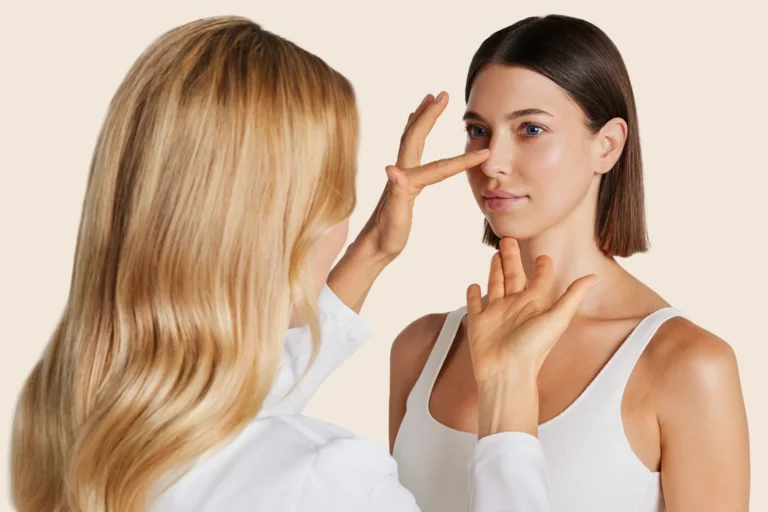Facts about nose surgery.
Transparent and informed about your desired nose.
The experience of the dream nose.
We accompany patients on their first look at their new dream nose.
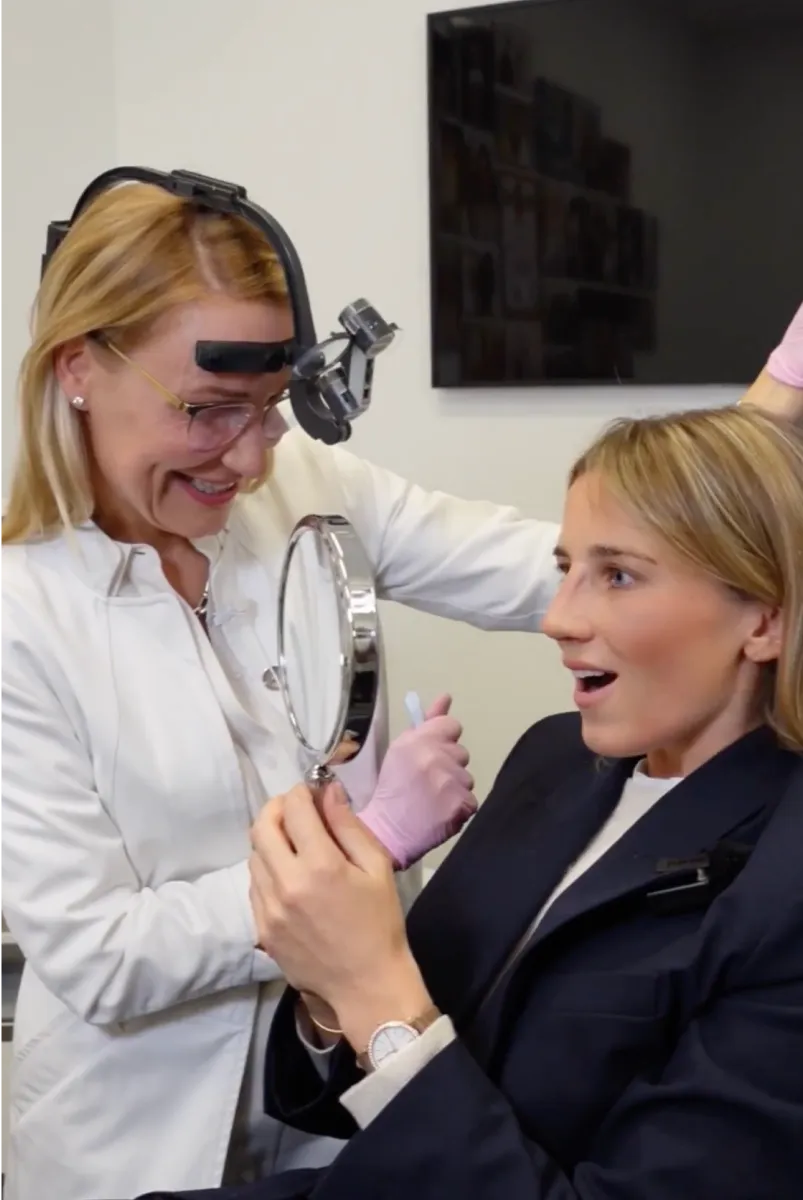


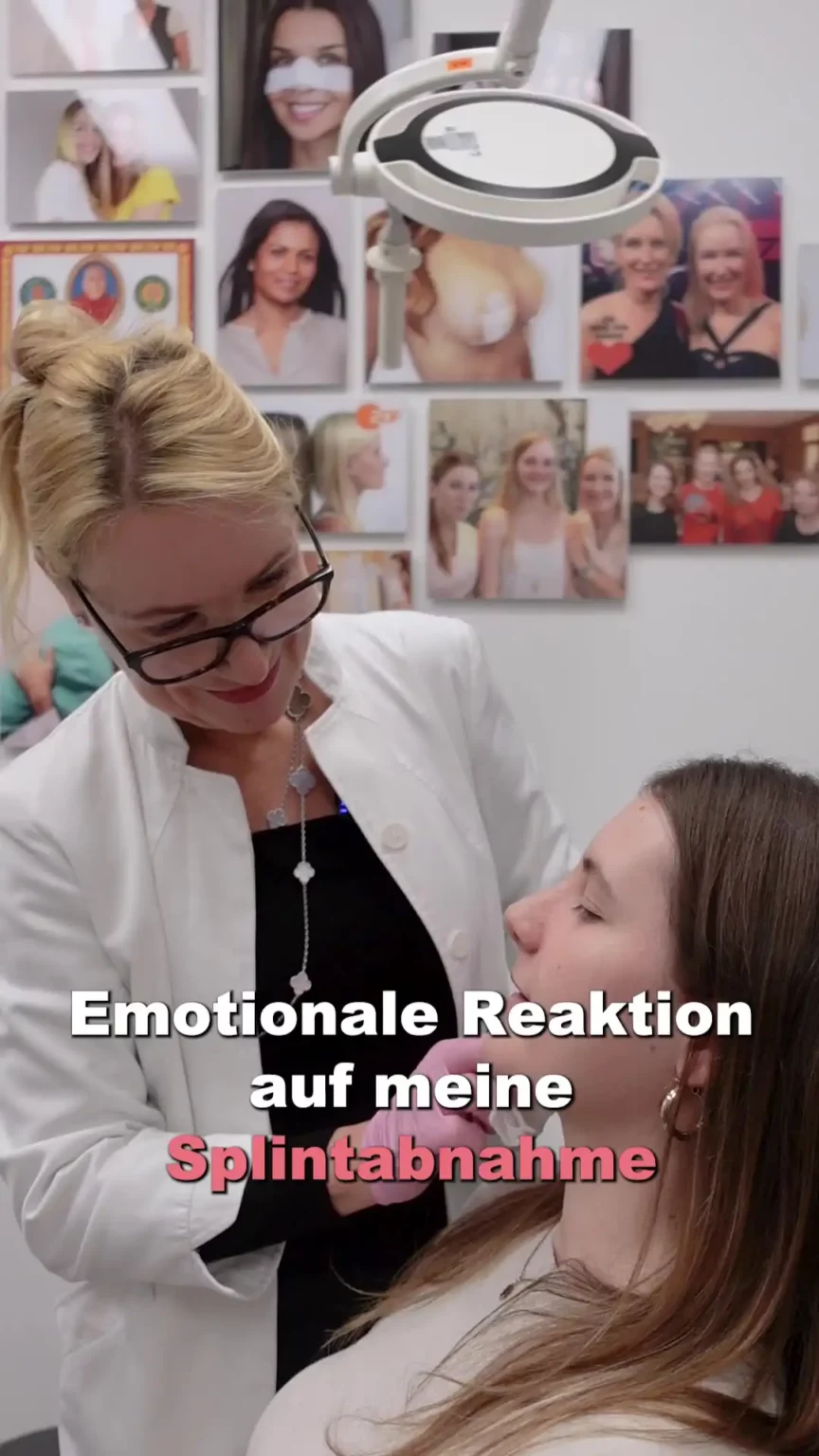

Your options with Dr. Berkei.
Every nose is individual and so is the technique used for rhinoplasty. When choosing a surgical procedure for a nose job, the shape of the nose determines which technique is required for correction. Depending on the shape of the nose and the type of crookedness, Dr. Berkei and her colleagues use the optimal methods to achieve your dream nose.
Which nose do you have?
Hump nose
To correct a humped nose, the excess cartilage and bone is removed and the bridge of the nose is reshaped to achieve a harmonious nose shape. In the case of a cartilaginous hump nose, the cartilaginous part of the nasal septum is straightened using positioning sutures and “spreader grafts”, small cartilage splints to open the inner nasal valve. In the case of a bony hump nose, bone is removed and the bridge of the nose is reconstructed.

Saddle nose
To restore a straight nasal bridge, a nasal septum operation is performed on a saddle nose in which the bridge of the nose is reshaped. To compensate for the missing material on the bridge of the nose, the patient ‘s own cartilage is used as a graft to reconstruct the bridge of the nose.

Crooked nose
Depending on the type of crookedness, the aesthetics and function of the nose are improved by straightening the cartilaginous part of the nasal septum or adjusting the asymmetrical bony nasal pyramid. It may be necessary to remove a hump to open the nasal roof in order to reposition the nasal axis.
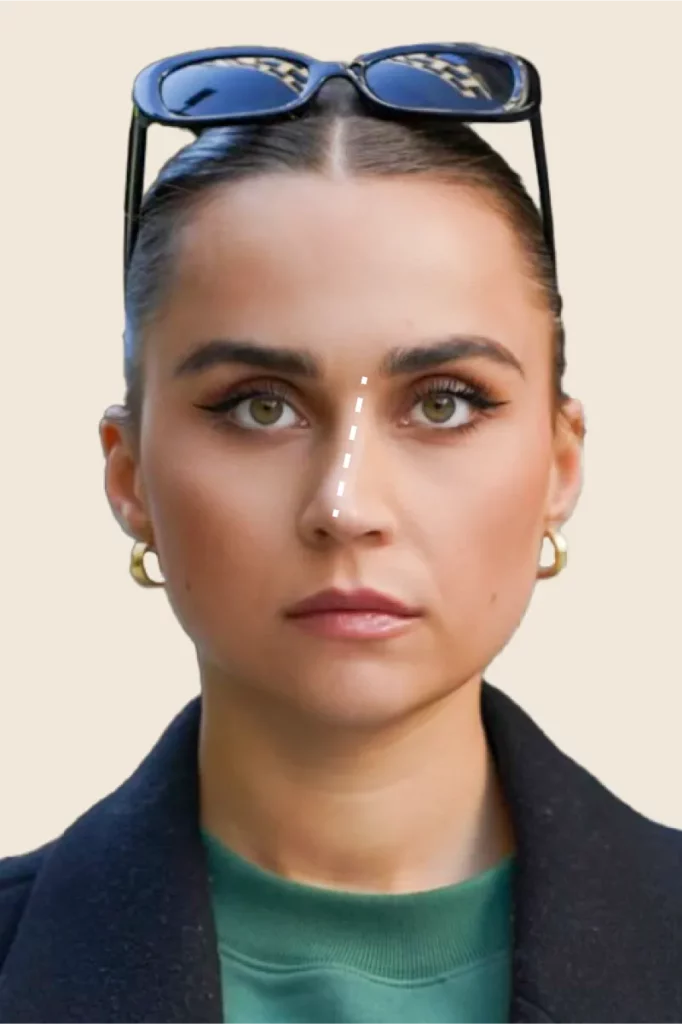
Pseudo-slanted nose
A pseudo crooked nose is an asymmetry of the two halves of the face. The center between the eyes does not correspond to the center between the upper lips, the face does not appear straight. This is usually a widening of one side of the face that occurs in almost every face and the nose is crooked in the face, although it starts in the middle between the eyes and runs centrally towards the upper lip.

Curved nasal septum (deviated septum)
A decision must be made here as to whether a bony-cartilaginous axial correction should be performed or whether a straightening by augmentation of the concave side with septal or ear cartilage should be carried out.
Enlarged turbinates (conchal caustic)
Enlarged turbinates, known as turbinate hypertrophy, are common in patients with long-term allergies and lead to ventilation problems. Nasal conchae are bones covered with mucous membrane that enlarge the surface of the nasal cavity. They are located on the outer wall of each nostril, with the inferior turbinate usually being the largest and often causing airway obstruction. Enlarged middle conchae can lead to airway obstruction due to concha bullosa. Partial reduction of the turbinates improves nasal ventilation, and recovery is quick and painless. Allergy sufferers may need another reduction of the mucosa after 1-2 years.




Impressive results.
Precisely shaped noses that fit perfectly into the face - the art of Dr. Berkei's rhinoplasty.


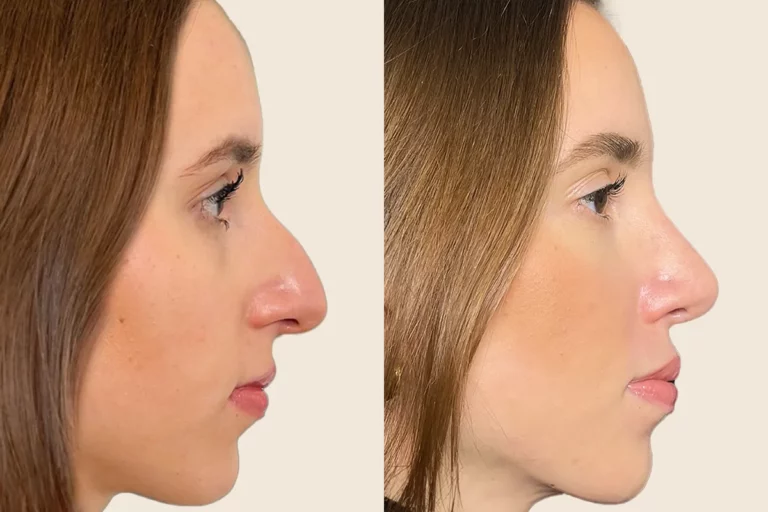

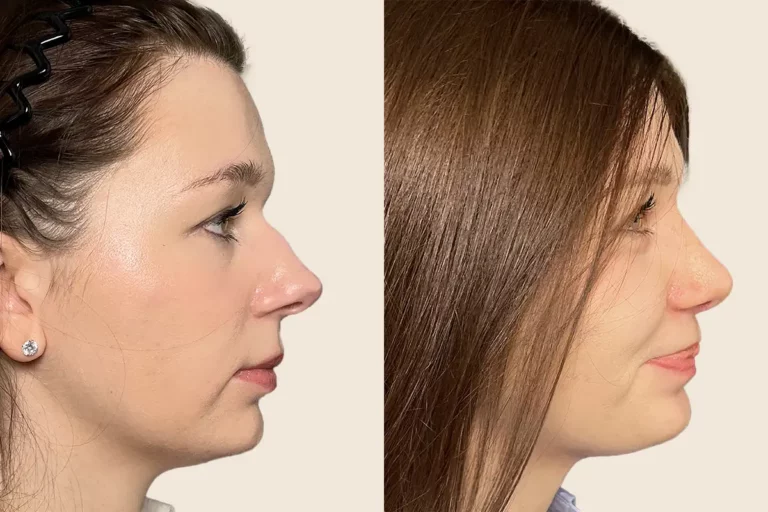

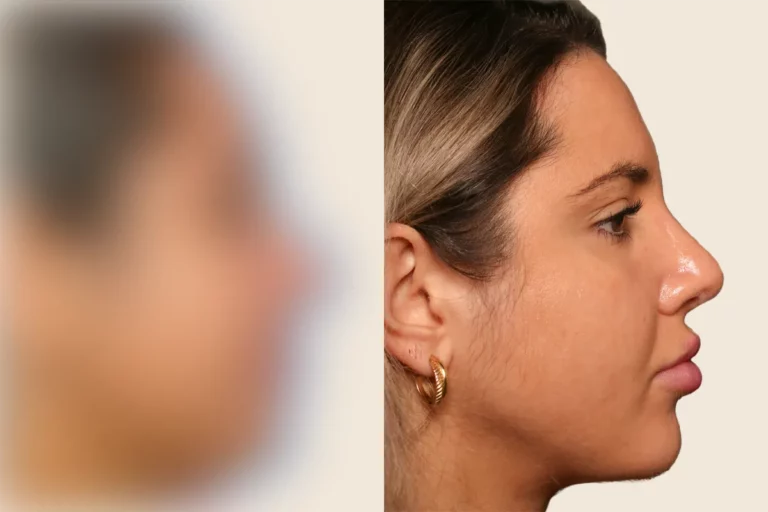


A passion for rhinoplasty.
In her more than 26-year career as a plastic and aesthetic surgeon, Dr. Julia Berkei specialized early on in performing rhinoplasty. Her many years of experience and working with a wide variety of noses have made her an internationally recognized expert in rhinoplasty.
Dr. Berkei performs rhinoplasty not only with the utmost care and precision, but also with a passion for artistic shaping and aesthetics. The realization of your wishes exactly according to your ideas is close to her heart. Having successfully performed thousands of rhinoplasties, she is able to consistently achieve perfectly natural results.
Dr. Berkei’s surgical work is characterized by a particularly low revision rate of less than 1%, which is far below the industry average of 15-20% for rhinoplasty. This high success rate is possible because Dr. Berkei works exclusively according to her “Nose by Berkei” concept, which has been perfected over many years and combines three complex operations for optimal results.
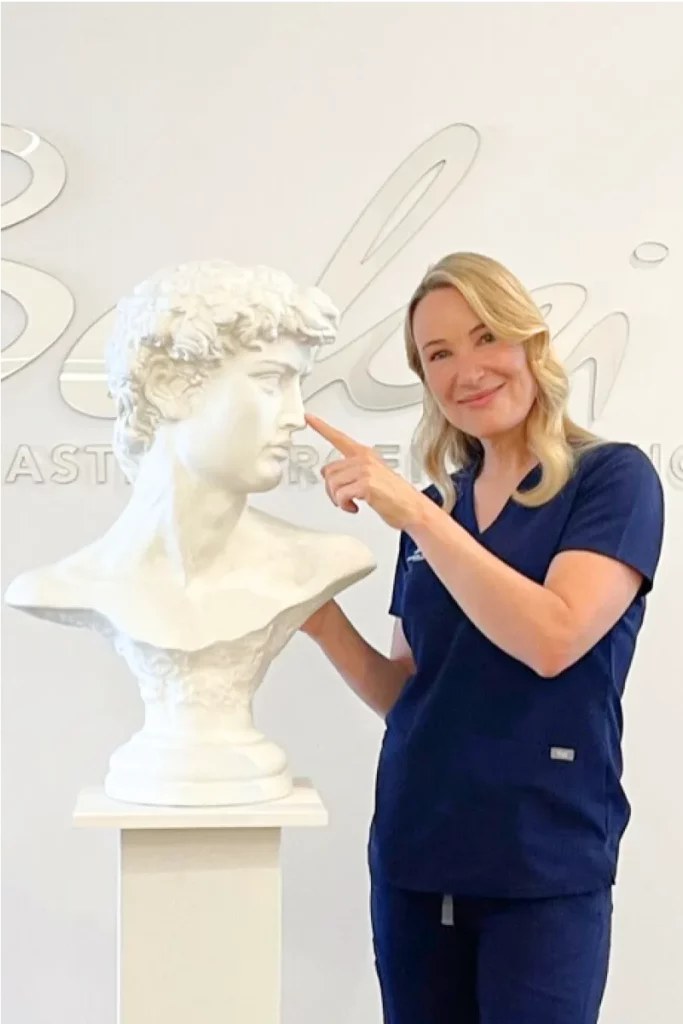
3D simulation of your dream nose.
All your wishes at a glance.
Noses shaped by Dr. Berkei give your patients a new attitude to life with more self-confidence and satisfaction. During your personal consultation, we take pictures of your nose, which we use to create a
3D computer simulation
of your nose. With the help of the computer simulation, your nose can be modified according to your wishes and individual options can be discussed with Dr. Berkei. Depending on the thickness of the skin, crookedness of the nasal septum, narrowing of the inner nasal valves or scarred tissue, you have different options for a nose operation. The simulation allows your treatment to be planned and discussed realistically and gives you a visual understanding of your possible nose after the operation.
You are currently viewing a placeholder content from YouTube. To access the actual content, click the button below. Please note that doing so will share data with third-party providers.
More InformationThe

Package.
Your safe route to recovery and your desired result.
Dr. Berkei and her colleagues have the highest standards for every single rhinoplasty and its result. Only by precisely following the B Safe concept developed by Dr. Berkei can Dr. Berkei and her colleagues reliably achieve perfectly natural results with a particularly high success rate. With the B Safe concept, you will recover quickly and with minimal pain after your nose operation. Thanks to the comprehensive prevention package and safety concept, you will achieve the best possible surgical result that meets your wishes and accompanies you for the rest of your life.
Procedure after rhinoplasty
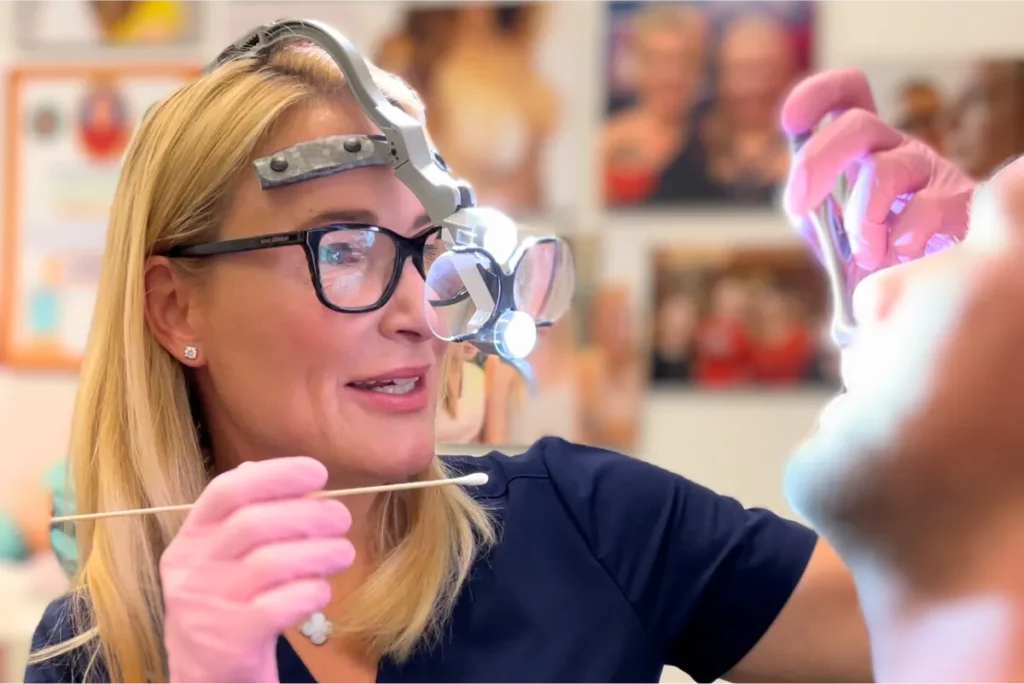
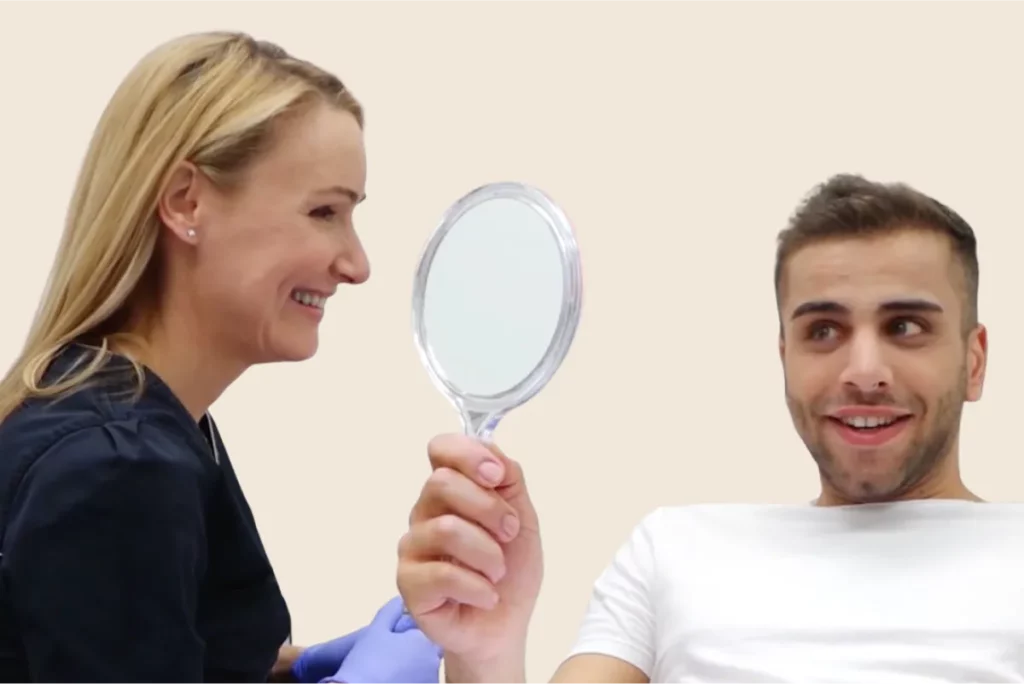
Stories of the journey to the dream nose.
With a nose job to a new attitude to life: Our patients share their story from the first wish for a different nose to the realization of their dream and thus encourage others to take the plunge. A small selection of the experiences of Dr. Berkei’s patients from more than 8,000 rhinoplasties performed.



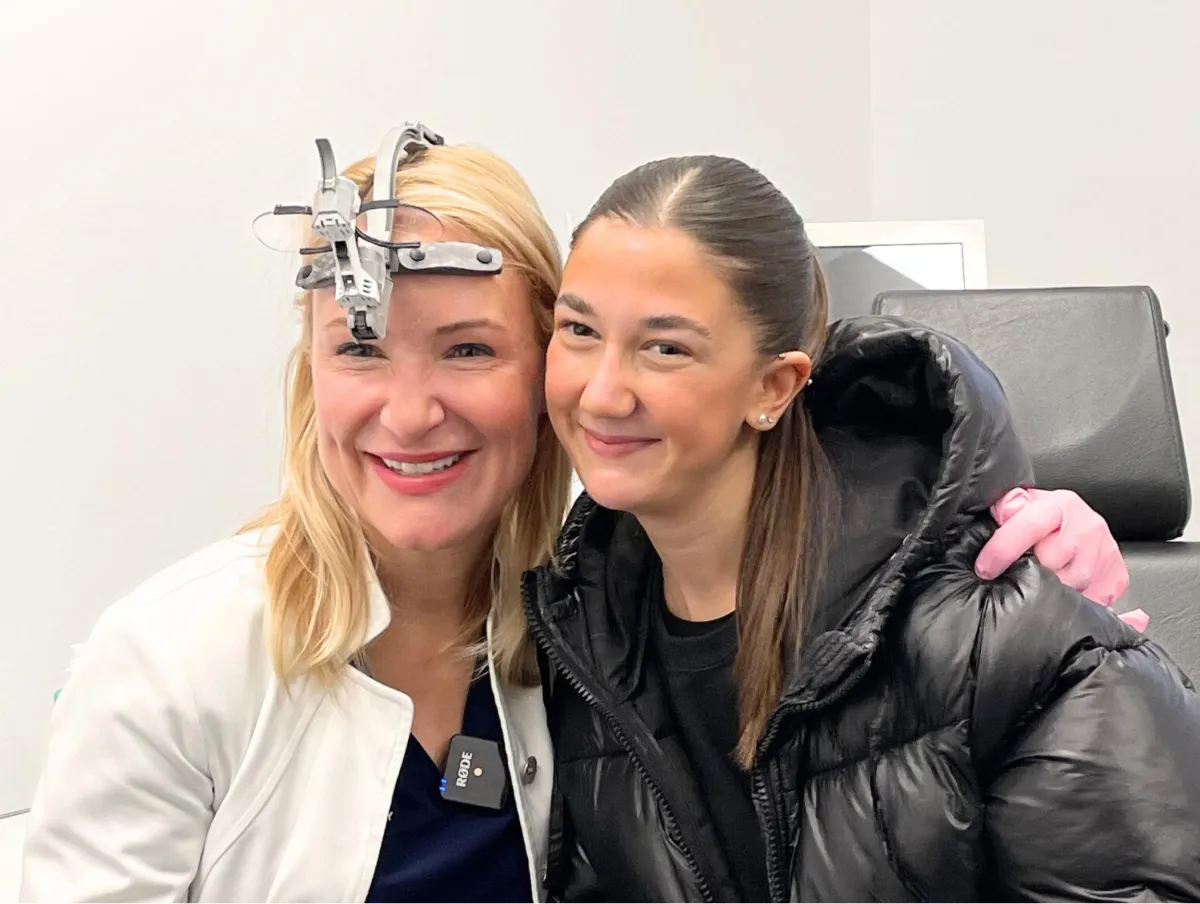

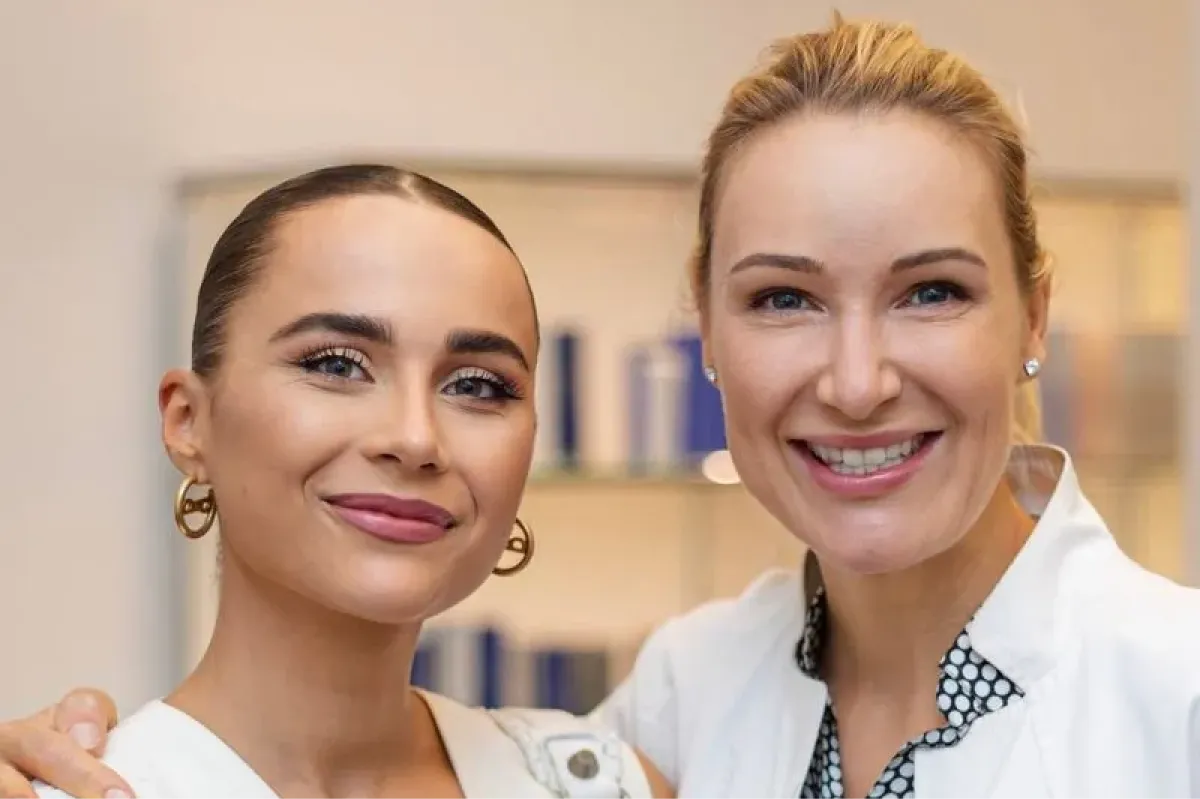
Aesthetic rhinoplasty.
Your journey to more self-confidence.
Many people want a nose that meets their own aesthetic expectations, such as a smaller nose, a defined nasal tip or a straight nasal bridge. There is often a desire for a natural nose that blends in beautifully with the patient’s face. Many patients decide to have their nose corrected by Dr. Berkei, especially if the shape of their nose causes them psychological distress, for example because they feel uncomfortable or are teased. Through personal consultation with 3D computer simulation and precise planning of the procedure, Dr. Berkei and her colleagues can create natural results that turn the patient’s dreams into reality.


Frequent problem areas
Each patient’s nose is individual, as are the ideas and dreams of the desired nose. The aim of Dr. Berkei and her colleagues is to give every patient their dream nose for life. Having performed more than 8,000 rhinoplasties, Dr. Berkei has extensive knowledge that enables her to create perfectly natural noses from any nose shape to suit the patient’s individual facial features. The decision to undergo rhinoplasty is a step that can change your life for the better and give you more self-confidence – for the rest of your life.
Functional rhinoplasty.
Breathe freely for a pleasant feeling of well-being.
The causes of a ventilation disorder can be varied and are usually due to anatomical changes. A crooked nasal septum, a malposition of the nose, a thickening of the septum or excessively thick turbinates can lead to impaired ventilation and thus to obstructed nasal breathing. A distinction must be made between narrowing of the airways due to a thickening of the mucous membranes, such as in the case of a cold or an allergy, and anatomical changes to the cartilage and bones, such as in the case of a crooked nasal septum, a septal ridge or enlarged turbinates.
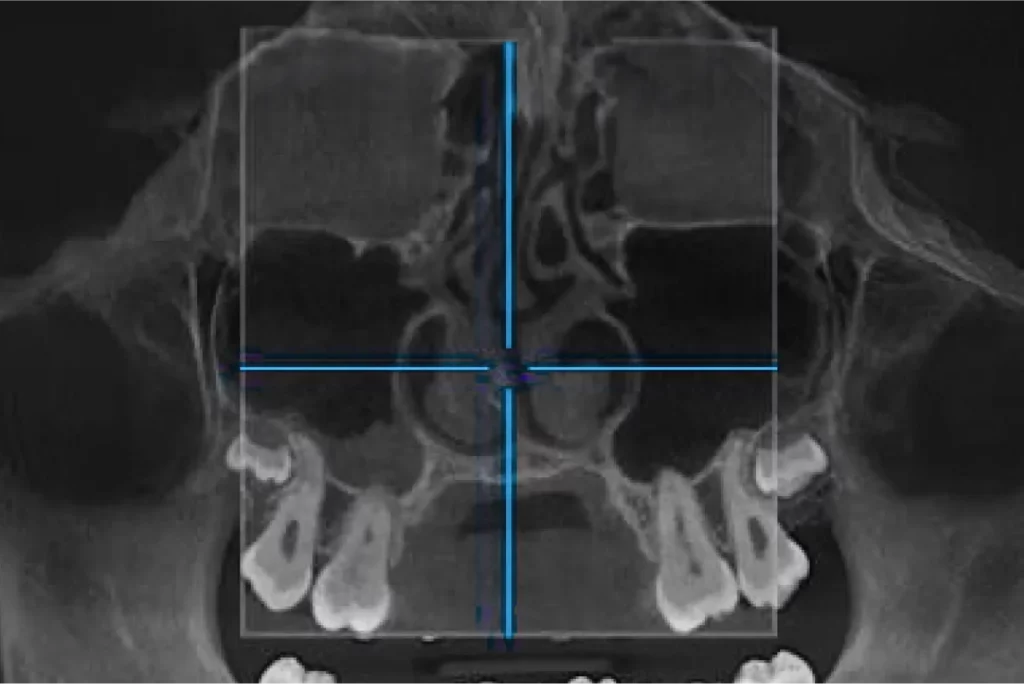

Symptoms of a ventilation disorder
A ventilation disorder caused by the shape of the nose can manifest itself in many ways. Patients often complain of a blocked nose, a dry mouth after waking up and a reduced sense of smell. Chronic nasal congestion and the resulting nosebleeds can also occur. If these symptoms are not treated, they can lead to serious chronic ventilation problems with insomnia, high blood pressure, sleep apnea syndrome and heart disease.
In the more than 8,000 rhinoplasties she has performed, Dr. Berkei uses effective techniques based on the patient’s individual requirements to help her patients achieve better breathing in the long term.
Digital volume tomography (DVT) or computer tomography (CT)
A DVT (digital volume tomography, also known as cone beam computed tomography CBTC) can be used for imaging diagnostics of the internal anatomy of the nose. Compared to imaging with computer tomography, a significantly higher image resolution is achieved with reduced radiation. The assessment of the nasal septum, the turbinates (conchae) and the complex structures of the paranasal sinuses is a prerequisite for planning functional septorhinoplasty.
Treatment of the internal nasal passages
In less complicated cases, the inner nasal passages can be treated without changing the outer nose in order to correct a functional ventilation disorder.
Nasal septum straightening (septorhinoplasty)
In nasal septum straightening, the wall dividing the right and left nostrils is bent, crooked, arched or twisted, which can lead to blockage of one or both airways (commonly known as a crooked septum or crooked nasal septum). Septoplasty uses a variety of surgical techniques to straighten the septal wall and clear the airway.
Reduction of the erectile tissue (shell acoustics)
The turbinates on the lateral wall of the nasal cavities can swell, making breathing difficult. Reducing the size of the erectile tissue in the affected areas, also known as conchal cavernosity, can clear the airways and make breathing easier.
Although a purely aesthetic rhinoplasty or a purely functional rhinoplasty are separate procedures, there are also patients who both a functional and a cosmetic improvement Dr. Berkei and her colleagues will be happy to address your specific wishes in your consultation and plan your treatment to achieve your desired result and feeling.
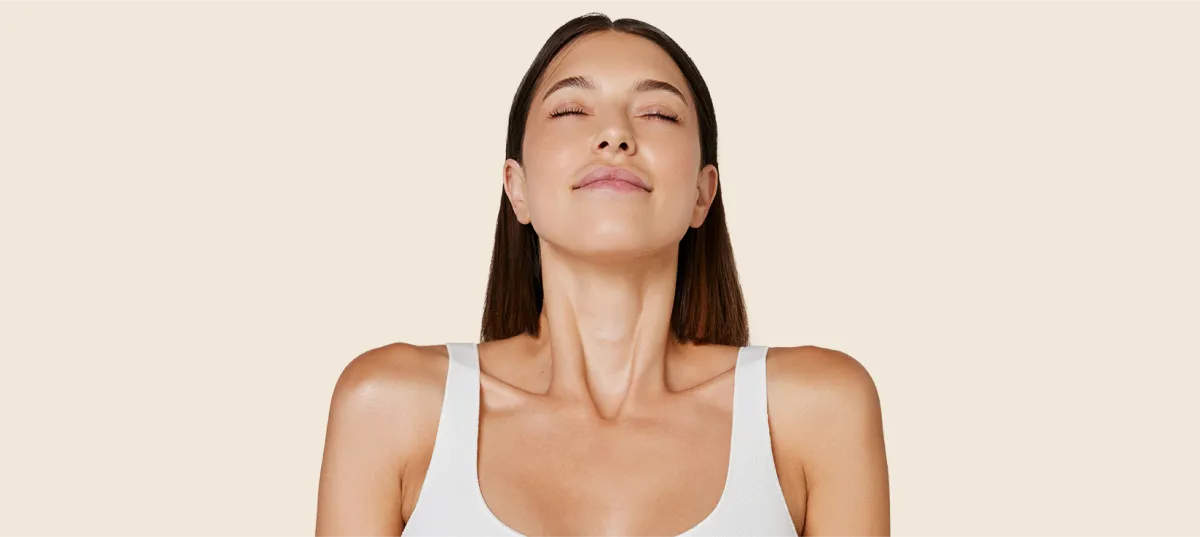
Complex revision rhinoplasty.
Finally your desired nose permanently.
Dr. Berkei is one of the few plastic surgeons who specializes in complex revision rhinoplasty. She is an expert in this field and performs rhinoplasties with a particularly high success rate of more than 99% and thus a revision rate of less than 1%. This creates results that patients are happy with for a lifetime. Unfortunately, this is not the norm, as 15-20% of all rhinoplasties worldwide do not lead to a permanently satisfactory result. Revision rhinoplasty is one of the most difficult surgical rhinoplasty procedures and is often referred to as the “king of rhinoplasty”. In her more than 26 years of experience, Dr. Berkei has specialized in performing this procedure with particular sensitivity and the utmost perfection.
The special feature of revision rhinoplasty is that the surgeon not only has to deal with scarred, pre-operated tissue and take functional and aesthetic aspects into account, but also has to recognize the patient’s particular psychological situation. Patients are often traumatized after unsuccessful previous operations and are understandably very anxious. That is why Dr. Berkei, as an expert in revision rhinoplasty, also treats every patient with a great deal of psychological understanding and empathy, which should make you as a patient feel safe at all times. With detailed joint planning, including 3D computer simulation, the objectives of the operation are precisely defined and you as the patient are informed transparently about every step at all times.
Breathing freely again: Kristine's rhinoplasty


Another nose job for lifelong satisfaction
Together with Dr. Berkei, a simulation of Kristine’s nose was created, whose adjustments were not only intended to solve her breathing problems, but also to give her nose the shape she wanted. Especially after the negative experience of her first rhinoplasty, the precise planning of her new nose helped Kristine to pluck up the courage to have another operation.
Despite the increased difficulty due to the previous surgery and the severe deformity, Dr. Berkei shaped Kristine’s nose with great precision to solve her breathing problems. Additional tissue was removed from the patient’s ear for nasal reconstruction. In addition, the left septum was removed, a conchal mastication was performed and spreader grafts were used to stabilize the nose.
Her second rhinoplasty finally allowed Kristine to breathe freely again and gave her her dream nose. A difficult decision that has now given Kristine a functional nose and satisfaction with her appearance for the rest of her life.


The most common problems
As an expert in revision rhinoplasty, Dr. Berkei offers tried and tested options to solve the problems with the operated nose in the long term and to the satisfaction of your patients.
Visible cartilage or bone
Especially with very thin nasal skin, cartilage or bone may be visible after a nose operation. Using tissue grafts to thicken the skin, Dr. Berkei restores the desired shape.
Crooked nose (deviated septum)
Inadequately performed nasal septum surgery often results in a deviated septum, a crooked position of the nose due to a curved nasal septum. A ventilation disorder can also be caused by a deviated septum. By removing thickenings of the nasal septum that lead to narrowing of the nasal passage, Dr. Berkei corrects the curvature of the nasal septum and straightens the nose.
Unstable nasal septum or hump
If an unwanted hump develops after a nose operation or if the nose is unstable, a transplant with autologous cartilage can provide more stability. During revision rhinoplasty with Dr. Berkei, the nasal septum is reconstructed so that the bridge of the nose once again corresponds to the patient’s wishes and remains permanently stable.
Drooping tip of the nose
With a drooping nasal tip, the cartilage is often too weak to keep the nasal tip stable. Small, individually cut cartilage grafts (tip shields, columella shields or tip grafts) can be used to reinforce the tip of the nose and restore the desired shape.
Wide nose tip
A nasal septum that is too long often results in a very wide nasal tip after a nose job. This can be remedied by shortening the nasal septum.
Scarring on the columella
The incision made on the columella during rhinoplasty to correct the nose can result in visible scarring. Dr. Berkei and her colleagues can remove these scars by carefully loosening them.
Especially after an operation without a satisfactory result, it is understandably difficult for many patients to pluck up the courage to confide in a doctor again. It is therefore particularly important to us to respond to your wishes and objectives and to provide you with a realistic and detailed plan for the revision operation. You should feel safe and comfortable with Dr. Berkei and her colleagues at all times. We are also happy to offer you second consultations, for example after swelling has been reduced. We are there for you and accompany you on your way to a carefree life.

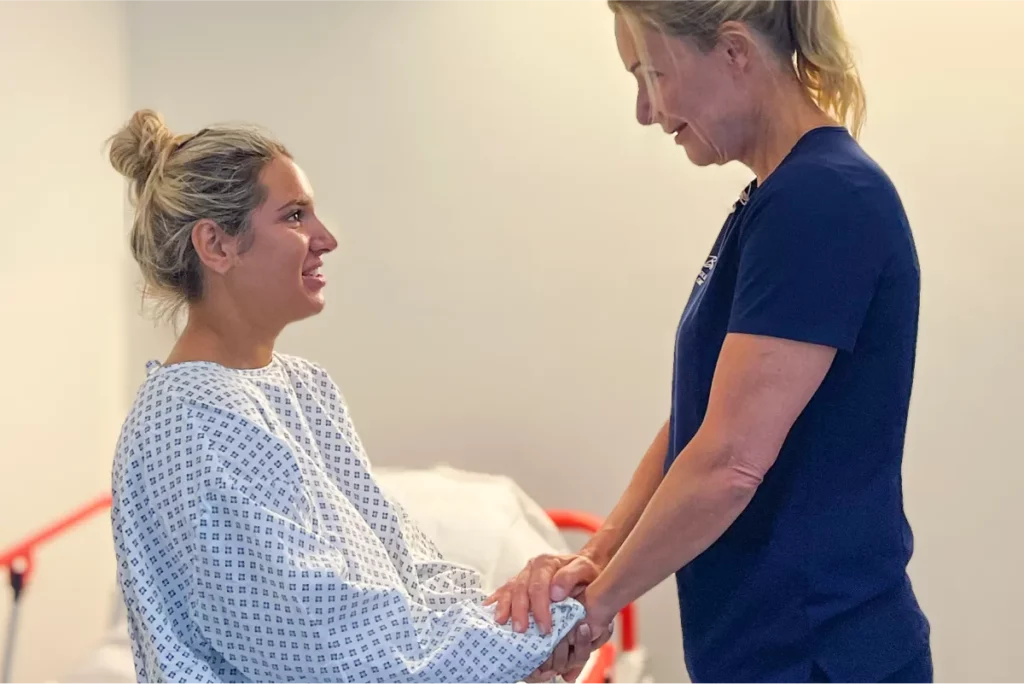
The influence of skin thickness.
The result of a nose job lasts a lifetime. This makes it all the more important to perform every single step of the operation precisely and to shape your nose based on your individual circumstances and wishes. Which nose shape is possible for you and when you will see the final result depends largely on the thickness of the skin on your nose. It is therefore particularly important that your rhinoplasty is planned in detail and individually in advance and that the possible results are discussed.
Therefore, the greatest challenge for patients with thin skin is to operate with extreme precision and leave a smooth bridge of the nose. Alternatively, grafts can be used (fascia, dermis, cartilage) or injected to increase the thickness of the skin.

Thick skin in particular is a challenge for the surgeon, as it is more difficult to shape. Targeted and very careful thinning of the skin, i.e. the removal of fat and connective tissue, can help to achieve the desired shape.

Recognize the skin thickness
During your personal consultation in our practice in Frankfurt, Dr. Berkei will examine your skin in order to plan your treatment and options precisely. This means you know in advance what is realistically possible and what results you can expect.
Our International Service.
An exclusive experience with personalized all-round carefree service.
A rhinoplasty with Dr. Berkei is not just a surgical treatment, but an exclusive journey that you will not soon forget.

The

In Dr. Berkei’s exclusive blog, you will gain deep insights into the technique of rhinoplasty, myths and facts about rhinoplasty and the latest trends in plastic and aesthetic surgery.
Answers to your questions.
We answer your questions transparently so that you know what to expect from a rhinoplasty before your treatment and consultation. If you have any further questions about rhinoplasty with Dr. Berkei, please do not hesitate to contact us using our contact form.
Removing tamponades after rhinoplasty surgery is painful. We do not want to expose our patients to this pain, so we do not routinely use tamponades and offer a pain-free alternative: Doyle Splints. The silicone tubes are inserted into the nose at the end of the operation and gently removed after a few days. In contrast to the classic tamponade, which consists of a strip of fabric, the Doyle Splints are smooth and soft and slide easily out of the nose without sticking.
In addition to surgical correction of the nose, it is also possible to fill small humps or depressions on the bridge of the nose with a filler to even them out. For this, we use the substance hyaluronic acid, which has proven its worth in this type of rhinoplasty. Please bear in mind that this is a volume addition. In this respect, injections usually only work well in patients with noses that are not too large.
Nose surgery using the Nose by Berkei technique includes functional and aesthetic rhinoplasty as well as static surgery. The supporting structures of the nose are reinforced with cartilage from the nasal septum to form a subterranean scaffold. Patients are also given an external nasal splint for two weeks. The nose is fully resilient again after 6-8 weeks.
Please do not shower too long or too hot in the first 2-3 weeks after a nose operation. Hair can be washed after 3-5 days with the head leaning back (please do not wash upside down). If water runs down your face, this is not a problem, just dab it off.
With the closed rhinoplasty technique, incisions are only made inside the nose. With the open technique, there is also a small incision on the nose bridge. While closed rhinoplasty was performed around 20 years ago, the last ten years have seen a strong shift towards the predominantly open technique. This offers many advantages due to better visibility of the anatomy.
There is no general answer to this question. You should be of legal age for an aesthetic rhinoplasty. Nose surgery can be performed at any age, provided the patient is in very good health. A functional rhinoplasty can also be performed on minors in special cases, for example in the case of severe ventilation disorders.
If there is a ventilation disorder in the nose due to a crooked nasal septum, a wide septum, enlarged turbinates/nasal cavernous bodies or a nasal skeleton that is too narrow or crooked, a complete rearrangement of the cartilaginous and bony nasal skeleton is part of the functional operation. The hump must also be removed and the nasal tip cartilage must be stabilized and straightened. The change in shape and the patient’s wishes, which play a major role in this, are of course discussed in detail beforehand in the 3D simulation.
Immediately after inserting the silicone tubes into the nose, a thermoplastic splint is placed on the nose to protect and splint it. The splint extends from the tip of the nose to the upper end of the bridge of the nose. It remains on the nose for approx. 14 days after the nose operation.
Dr. Berkei uses the open technique for her rhinoplasties. Their argument: with the open technique, more extensive steps can be carried out to correct the tip of the nose, the bridge of the nose can be straightened more optimally and greater precision can be achieved than with closed surgery.
The duration of rhinoplasty surgery is as individual as the patient themselves and depends on the surgical technique chosen. The patient’s wishes and individual circumstances can also have an impact on the duration of the rhinoplasty. The duration of the procedure usually varies between 2 and 3 hours for a primary rhinoplasty, while the procedure can take 3-6 hours for a revision rhinoplasty.
We accompany you on the way to your desired nose shape. Secure your personal consultation now with a comprehensive analysis of your nose and individual options.



